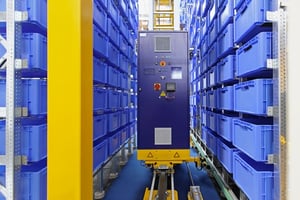 Having forward picking locations that are periodically replenished out of a bulk zone can boost efficiency greatly. There are some situations though where that strategy leads to inefficiency and duplicated efforts. In these cases, using common bin locations in your forward staging area may be a great way to cut down on contacts and movement of your products. Let's discuss some of these scenarios.
Having forward picking locations that are periodically replenished out of a bulk zone can boost efficiency greatly. There are some situations though where that strategy leads to inefficiency and duplicated efforts. In these cases, using common bin locations in your forward staging area may be a great way to cut down on contacts and movement of your products. Let's discuss some of these scenarios.
Imagine you have an item that is normally stocked in a forward pick location with a capacity of 25 units. Your WMS allows the location to be picked down to 10 units before triggering a warehouse replenishment order to refill it. What happens when you receive an order for 55 units of that product?
Without some sort of special process for this scenario, you might see your picking team empty the bin by short picking it to zero, wait for it to be refilled, empty it again, wait for it to be replenished a second time and then pick the final five pieces. It may be that you have three forward pick locations for this part, each of which contains up to 25 piecces. This is better, because the WMS may direct your pickers to pull the same item from multiple forward stock locations, so they don't have to wait for replenishments, but they are still traveling through the warehouse.
In either scenario, your replenishment team has to repeatedly move products in small batches to meet the demand of a single order. This is where forward staged common bin locations would come in handy.
With common bin locations, you can tell your WMS to divert any large scale orders to the forward staged bulk location instead of to the main picking area. Thus, your replenishment team won't be forced to move the same product over and over in small batches, and your pickers won't be sent on a wild goose chase through the warehouse.
Multi-Channel Fulfillment
In addition to very large orders, multi-channel fulfillment can also benefit from common bin locations. In this instance, you may have one team of pickers who work exclusively on filling orders to retailers while a different team works on fulfilling orders for online sales directly to the consumer. Your WMS will be able to recognize these two types of orders and create two different picking strategies for them. Pickers could be sent directly to the common bin location to pull big orders of like items for retailers while being directed to the regular stock locations if they are pulling orders of many unlike items for consumers. These two strategies will help maximize the efficiency of fulfilling both types of orders within one shared warehouse space.
These are just two of the ways that common bin locations can be leveraged to improve the performance of your warehouse replenishment team. If you are dealing with orders that disrupt the normal flow of product through your warehouse because of their size, it is worth considering how your WMS can divert some of those orders to a common bin location instead.




